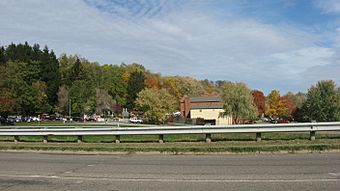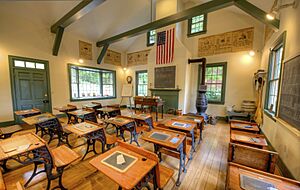Roscoe Village (Coshocton, Ohio) facts for kids
Quick facts for kids |
|
|
Roscoe Village
|
|

Distant view from the south
|
|
| Location | Whitewoman and High Sts., Coshocton, Ohio |
|---|---|
| Built | 1816 |
| Architectural style | Classical Revival, Greek Revival |
| NRHP reference No. | 73001403 |
| Added to NRHP | April 3, 1973 |
Roscoe Village is a special historic town in Coshocton, Ohio, United States. It was once a busy port along the Ohio and Erie Canal. Today, it has been carefully restored to look like it did in the 1800s.
The town was first planned in 1816 by a man named James Calder. He named it Caldersburgh. After some financial trouble, Calder moved across the Muskingum River. He opened a new store and hoped local farmers would shop there instead of paying for a ferry to Coshocton. In 1830, the town was renamed Roscoe. This was to honor William Roscoe, a famous English writer and activist against slavery.
Contents
Roscoe Village: A Canal Town
How the Canal Changed Roscoe
Roscoe was a quiet village until the Ohio and Erie Canal arrived. On August 21, 1830, the first canal boat, the Monticello, landed there. This event changed Roscoe forever. The canal offered a cheap way to move people and goods. This brought a lot of growth and money to towns along its path.
Busy Life on the Canal
Roscoe quickly became a very important place. It was the fourth largest port for shipping wheat on the canal. This success led to many new businesses opening. There was a blacksmith who made and repaired metal items. A cooperage made wooden barrels. There was also a hotel, a mill for grinding grain, and several stores. Today, State Route 16 follows the path where the old Ohio and Erie Canal used to be.
The End of the Canal Era
The canals were used until a big flood in 1913. However, their busiest days ended when railroads became popular. Trains could move goods faster and more efficiently. As the canal industry faded, Roscoe's success also declined. The once lively canal port and its beautiful buildings began to fall apart.
Bringing History Back to Life
The Idea for Restoration
In 1960, people started thinking about restoring Roscoe's history. This idea grew stronger after a mural called "Canal Days" was shown. The famous artist Dean Cornwell painted it for Coshocton's 1961 150th anniversary celebration. The mural showed a busy canal scene from Roscoe Village in the 1850s. This large painting is now in a bank in Coshocton. A smaller copy is in the Roscoe Village Visitor Center.
The Montgomery Family's Vision
Edward E. Montgomery, a retired local businessman, and his wife, Frances, were inspired by the painting. In August 1968, they bought the old Toll House from 1840. This was the start of restoring Historic Roscoe Village. Mr. Montgomery wanted Roscoe Village to be "a living museum." He hoped people could visit and experience life in the 1800s. He imagined old brick buildings, women in hoop skirts, and charming shops bringing the canal era back to life. Today, Roscoe Village is a result of over 35 years of hard work.
Learning About the Past
The Roscoe Village Foundation also works to teach people about life along the Ohio and Erie Canal in the mid-1800s. They offer "living history" displays where you can see how people lived and worked. Many events are held each year, attracting visitors from all over the country.
The Johnson-Humrickhouse Museum
The Johnson-Humrickhouse Museum is also located in Roscoe Village. It displays beautiful decorative arts, items from pioneers and Native Americans, and exhibits about local history.




